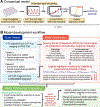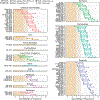Assessing proarrhythmic potential of environmental chemicals using a high throughput in vitro-in silico model with human induced pluripotent stem cell-derived cardiomyocytes
- PMID: 37921411
- PMCID: PMC10898275
- DOI: 10.14573/altex.2306231
Assessing proarrhythmic potential of environmental chemicals using a high throughput in vitro-in silico model with human induced pluripotent stem cell-derived cardiomyocytes
Abstract
QT prolongation and the potentially fatal arrhythmia Torsades de Pointes are common causes for withdrawing or restricting drugs; however, little is known about similar liabilities of environmental chemicals. Current in vitro-in silico models for testing proarrhythmic liabilities, using human induced pluripotent stem cell-derived cardiomyocytes (hiPSC-CM), provide an opportunity to address this data gap. These methods are still low- to medium-throughput and not suitable for testing the tens of thousands of chemicals in commerce. We hypothesized that combining high-throughput population- based in vitro testing in hiPSC-CMs with a fully in silico data analysis workflow can offer sensitive and specific predictions of proarrhythmic potential. We calibrated the model with a published hiPSC-CM dataset of drugs known to be positive or negative for proarrhythmia and tested its performance using internal cross-validation and external validation. Additionally, we used computational down-sampling to examine three study designs for hiPSC-CM data: one replicate of one donor, five replicates of one donor, and one replicate of a population of five donors. We found that the population of five donors had the best performance for predicting proarrhythmic potential. The resulting model was then applied to predict the proarrhythmic potential of environmental chemicals, additionally characterizing risk through margin of exposure (MOE) calculations. Out of over 900 environmental chemicals tested, over 150 were predicted to have proarrhythmic potential, but only seven chemicals had a MOE < 1. We conclude that a high-throughput in vitro-in silico approach using population-based hiPSC-CM testing provides a reasonable strategy to screen environmental chemicals for proarrhythmic potential.
Keywords: environmental chemicals; human-induced pluripotent stem cell-derived cardiomyocytes (hiPSC-CM); in vitro-in vivo extrapolation (IVIVE); proarrhythmic potential; ventricular arrhythmia Torsade de Pointes (TdP).
Plain language summary
This article discusses a new method for testing the potential harmful effects of environmental chemicals on the heart. We used human heart cells grown in a lab to test the chemicals and developed a computer model to predict their potential to cause dangerous heart rhythms. This method could help identify harmful chemicals more quickly and accurately than current testing methods. The study has the potential to improve evaluation of chemical risks and protect public health without the use of animals.
Conflict of interest statement
Conflict of interest
The authors declare they have no conflicts of interest.
Figures






Similar articles
-
International Multisite Study of Human-Induced Pluripotent Stem Cell-Derived Cardiomyocytes for Drug Proarrhythmic Potential Assessment.Cell Rep. 2018 Sep 25;24(13):3582-3592. doi: 10.1016/j.celrep.2018.08.079. Cell Rep. 2018. PMID: 30257217 Free PMC article.
-
Detection of Drug-Induced Torsades de Pointes Arrhythmia Mechanisms Using hiPSC-CM Syncytial Monolayers in a High-Throughput Screening Voltage Sensitive Dye Assay.Toxicol Sci. 2020 Feb 1;173(2):402-415. doi: 10.1093/toxsci/kfz235. Toxicol Sci. 2020. PMID: 31764978 Free PMC article.
-
Proarrhythmia Risk Assessment in Human Induced Pluripotent Stem Cell-Derived Cardiomyocytes Using the Maestro MEA Platform.Toxicol Sci. 2015 Sep;147(1):286-95. doi: 10.1093/toxsci/kfv128. Epub 2015 Jun 27. Toxicol Sci. 2015. PMID: 26117837
-
Moving beyond the comprehensive in vitro proarrhythmia assay: Use of human-induced pluripotent stem cell-derived cardiomyocytes to assess contractile effects associated with drug-induced structural cardiotoxicity.J Appl Toxicol. 2018 Sep;38(9):1166-1176. doi: 10.1002/jat.3611. Epub 2018 Feb 27. J Appl Toxicol. 2018. PMID: 29484688 Review.
-
Development of torsadogenic risk assessment using human induced pluripotent stem cell-derived cardiomyocytes: Japan iPS Cardiac Safety Assessment (JiCSA) update.J Pharmacol Sci. 2018 Dec;138(4):233-239. doi: 10.1016/j.jphs.2018.10.010. Epub 2018 Oct 24. J Pharmacol Sci. 2018. PMID: 30415824 Review.
Cited by
-
Incorporating new approach methods (NAMs) data in dose-response assessments: The future is now!J Toxicol Environ Health B Crit Rev. 2025 Jan 2;28(1):28-62. doi: 10.1080/10937404.2024.2412571. Epub 2024 Oct 10. J Toxicol Environ Health B Crit Rev. 2025. PMID: 39390665 Review.
References
MeSH terms
Grants and funding
LinkOut - more resources
Full Text Sources
Miscellaneous

